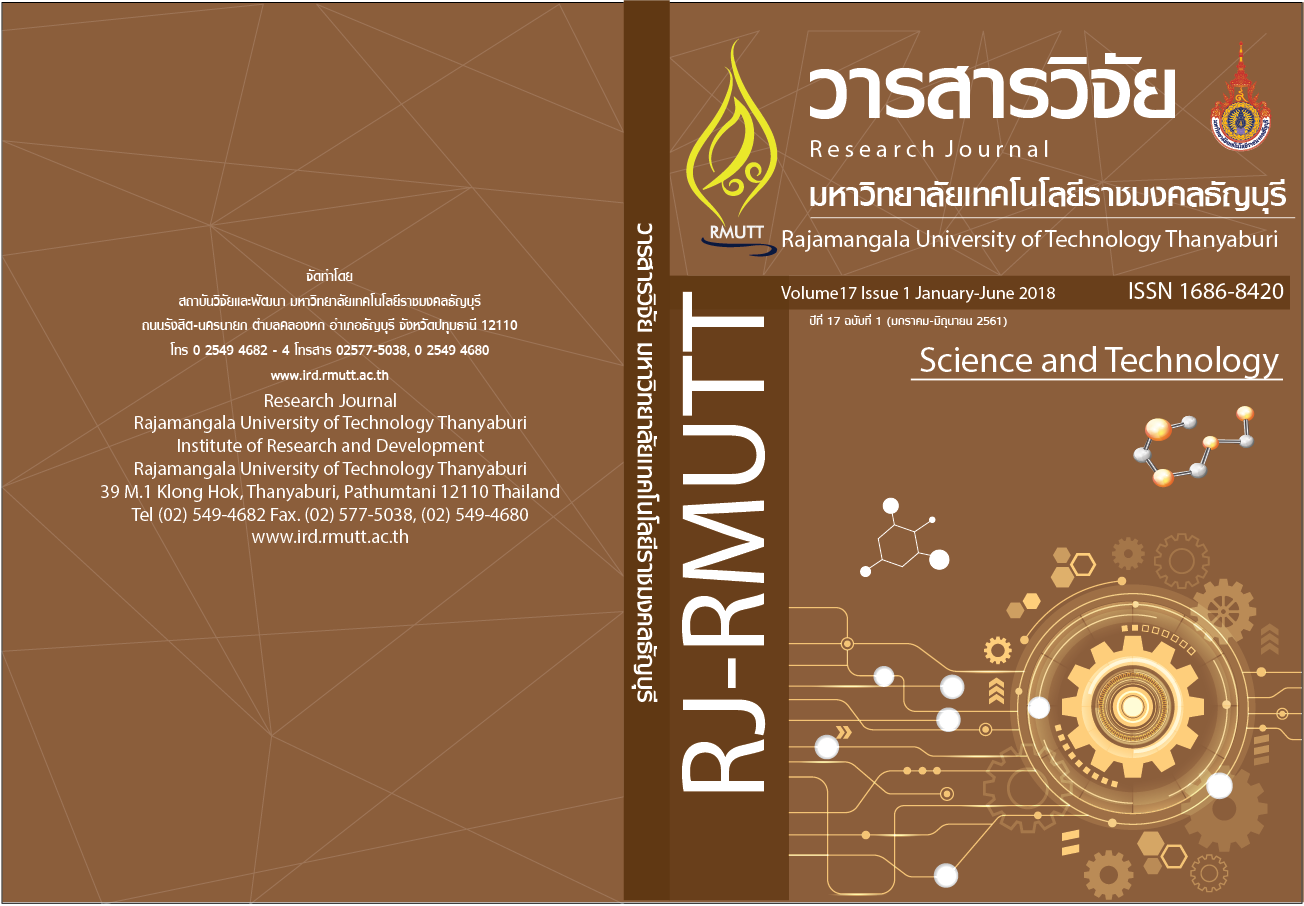Utilization of black Mao pomace extract in hand cleansing gel product
Main Article Content
Abstract
This research aims to study the utilization of black Mao pomace extract by studying the optimal extraction condition from Mao pomace and applying the extract in hand cleansing gel product. The result was showed that the optimal extraction condition was 50% of ethanol and 72 hours extraction time. The extract had total phenolic at 6,005.84 mg gallic acid/100 ml, antioxidant activity at 7,175.11 mg ascorbic acid /100 ml, total anthocyanin at 87.00 mg cyanidin-3-glucoside /100 ml. The inhibition effective of E. coli, P. aeruginosa, S. aureus and E. hirae were 7.67, 7.33, 6.50 and 6.50 mm. respectively. From the used of Mao pomace extract developed hand cleansing gel product, it was showed that the optimal amount of the Mao pomace extract was 5%. The product viscosity was 9,388 cP, pH was 5.44 and the color values (L*, C* and ho) were 35.84, 11.98 and 356.33, respectively. The product had total phenolic at 2.70 mg gallic acid/ 100 ml, antioxidant activity at 3.79 mg ascorbic acid/100 ml, anthocyanin at 16.70 mg cyanidin-3-glucoside/100 ml and the inhibition clear zone of E. coli, S. aureus, E. hirae and P. aeruginosa was 8.17, 8.50, 8.50 and 8.50, respectively. Consumer acceptant test showed that the overall liking score was moderately (7.29 from 9-point scale). There were 88% of consumers accepted the developed product and 76% of consumer would like to purchase the product.
Article Details
References
D. Puangpronpitag, P. Areejitranusorn, P.Boon siri,M. Suttajit and P. Yongvanit. (2008), ntioxidant activities of polyphenolic compounds isolated from Antidesma thwaitesianum Müll. Arg. seeds and marcs.Food Sci, 73(9), 48-53.
วัลยา เนาวรัตน์วัฒนา และพัชรี บุญศิริ. (2542). โปรออกซิแดนซ์:อีกโฉมหน้าของแอนติออกซิแดนซ์. วิทยาศาสตร์, 53(3), 196-198.
ศุภชัย สมัปปิโต. (2554). มะเม่า. กรุงเทพฯ:สำนักพิมพ์โอเดียนสโตร์.
อุไรวรรณ พานิช. (2555). สารต้านอนุมูลอิสระกับการยับยั้งความเสื่อมสภาพของผิวหนัง. ใน วรพล เองวานิช (บรรณาธิการ). อนุมูลอิสระและสารต้านอนุมูลอิสระ.(น. 357-384). เชียงใหม่: สำนักพิมพ์นวัตกรรมสุขภาพ.
M. Massara, S.B. Khedir, M.B. Salem, W. Regaieg and T. Rebai. (2017). Antioxidant and antimicrobial activities of ethanol and aqueous extracts from Urtica urens. Pharmaceutical Biology. 55(1), 775-781.
S. Karakaya, El. SN. and A. TAS. (2001). Antioxidant activity of some foods containing phenolic compounds. International Food Sciences and Nutrition 52(6), 501–508.
J. Daduang,S. Vichitphan, S. Daduang, P. Hongsprabhas and P. Boonsiri. (2011). High henolics and antioxidant of some tropical vegetables related to antibacterial and anticancer activities. African Pharmacy and pharmacology 5(5), 8-15.
M.M. Giusti and R.E. Wrolstad. (2001).Charcterization and measurement of anthocyanins by UV-Visible spectrocscopy.In R.E. Wrolstad (Ed.). Current Protocols in Food Analytical Chemistry. (pp. F1.2.1-F1.2.13), New York, John Wiley & Sons Inc.
ปิยวดี เจริญวัฒนะ, สุมนา ปานสมุทร, ดำรง คงสวัสดิ์ และอำนวย เพชรประไพร. (2552). การศึกษาฤทธิ์ในการยับยั้งจุลินทรีย์ของสารสกัดจากบัวหลวง. ปทุมธานี: มหาวิทยาลัยเทคโนโลยีราชมงคลธัญบุรี.
สุรเทพ ธนียวัน. (2552). การผลิตเจลล้างมือฆ่าเชื้อ. สืบค้นจากhttp://www.tistr.or.th/tistr/code/tistrorg/news.
M. Meilgaard, G.V. Civille and B.T. Carr. (1999). Sensory evaluation techniques. (3rded). New York: CRC pass.
ปฏิวิทย์ ลอยพิมาย, ทิพวรรณ ผาสกุล และราตรี มงคลไทย. (2554). เปรียบเทียบฤทธิ์การต้านอนุมูลอิสระและสารประกอบ ฟีนอลิกรวมของเปลือกผลไม้. วิทยาศาสตร์การเกษตร 42(2),385-388.
อธิยา เรืองจักรเพ็ชร. (2550). ผลของปฏิกิริยาการเกิดสีน้ำตาลในมะขามป้อม และอายุของมะกอกน้ำต่อปริมาณฟีนอลิก ฟลาโวนอยด์และกิจกรรมของสารต้านออกซิเดชัน. (วิทยานิพนธ์ปริญญามหาบัณฑิต, มหาวิทยาลัยเกษตรศาสตร์)
นิศารัตน์ ศิริวัฒนเมธานนท์. (2559). สารเคมีที่มีประโยชน์จากผักผลไม้ที่มีสีม่วงและสีน้ำเงิน. สืบค้นจากhttp://www.pharmacy.mahidol.ac.th/th/knowledge/article/152
ยุพาพร ผลาขจรศักดิ์. (2547). การสกัดและความคงตัวของแอนโทไซยานินที่สกัดได้จากเปลือกมังคุด. (วิทยานิพนธ์ปริญญามหาบัณฑิต,มหาวิทยาลัยศิลปากร).
พิมพร ลีลาพรพิสิฐ. (2551). เครื่องสำอางสำหรับผิวหนัง. พิมพ์ครั้งที่ 2. กรุงเทพฯ: สำนักพิมพ์โอเดียนสโตร์.
H. Flober-Muller, S. Champ, C. Kandzia, K. Jung, M. Seifert and T. Herrling. (2008). Strategy for Efficient Prevention from photo-ageing. SOFW Journal 134(8), 23-32.
A.K. Mishra, A. Mishra and P. Chattopadhyay (2011). Herbal cosmeceuticals for photo-protection from Ultraviolet B radiation. Tropical Journal of Pharmaceutical Re-search 10(3), 351-360.
I. Kusumawati, and G. Indrayanto. (2013). Natural antioxidants in cosmetic. Oxford United kingdom: Elsevier press.
M. Senful, E. Yildiz, N. Gungor, B. Cetin, Z.Eder and S. Ercisli. (2009). Total phenolic content, antioxidant and antimicrobial activities of some 170 medicinal plants. Pakistan Pharmaceutical Science. 22(1), 102-106.
B. Shan, Y.Z. Cai, J.D. Brooks and H. Corke. (2007). The in vitro antibacterial activity of dietary spice and medicinal herb extract. Food Microbiology. 117(1): 112-119.
ลือชัย บุตคุป. (2551). การศึกษาสารออกฤทธิ์ทางชีวภาพในเม่าหลวงสายพันทางการค้าจากภาคตะวันออกเฉียงเหนือของประเทศไทยเพื่อการผลิตเครื่องดื่มและไวน์แดง. (วิทยานิพนธ์ปริญญาดุษฎีบัณฑิต,มหาวิทยาลัยมหาสารคาม

